What is feline cerebellar hypoplasia?
View this post on Instagram
Cerebellar hypoplasia (CH), also known as “wobbly cat syndrome,” is a condition where the cerebellum — the part of the brain responsible for movement and coordination — is underdeveloped. This can lead to a variety of symptoms, including head tremors, incoordination, and difficulty walking. Cats with cerebellar hypoplasia often have a wide–based stance and a lack of coordination, causing some people to describe them as appearing drunk.
There is no cure or treatment for cerebellar hypoplasia, but most affected cats can learn to adapt and live relatively normal lives. The severity of the condition can vary greatly from cat to cat, and some may only have mild symptoms while others may be severely affected.
What is the cause of cerebellar hypoplasia in cats?
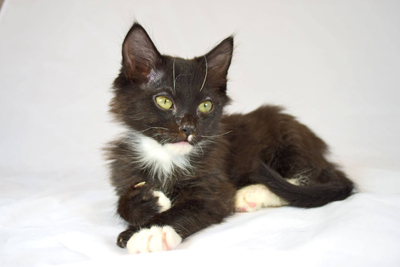
Cerebellar hypoplasia occurs in utero, often when a pregnant cat is exposed to a virus like feline panleukopenia, causing her kittens to be born with underdeveloped cerebellums. Thankfully, CH is not contagious and cannot be passed on to other cats or animals.
There are other potential causes of cerebellar hypoplasia in cats, including nutritional deficiencies and exposure to toxins
How is cerebellar hypoplasia diagnosed in cats?
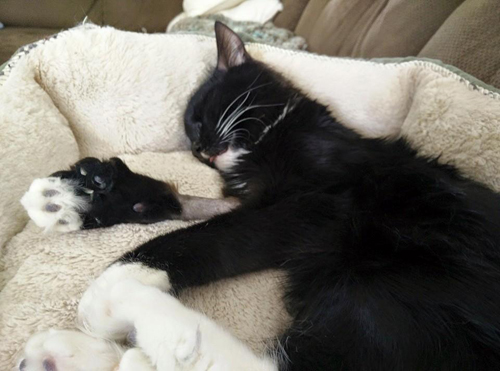
There are a couple ways to diagnose cerebellar hypoplasia in cats. One method is through a neurological examination that will assess the cat’s ability balance, motor skills, and coordination. However, an exam conducted by a neurologist won’t yield an absolutely definitive diagnosis.
The only way to diagnose cerebellar hypoplasia with complete certainty is through imaging tests such as computed tomography (CT) or magnetic resonance imaging (MRI), as these tests can show if a cat has a smaller than normal cerebellum.
How can I best care for a cat with cerebellar hypoplasia?
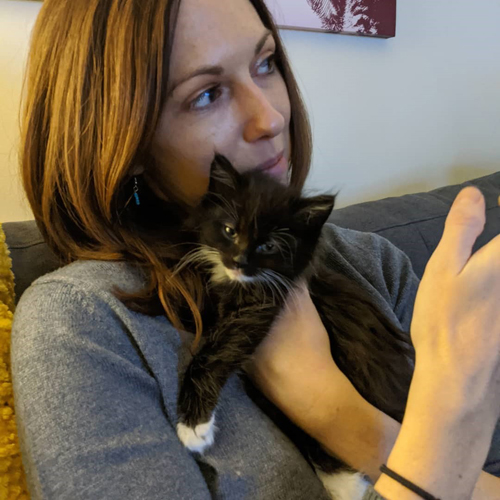
There is no one definitive way to care for a kitty with CH, as each cat‘s individual needs will vary depending on the severity of their cerebellar hypoplasia and their unique symptoms. However, some tips that may help include:
- Providing a safe and stable environment for your cat to move around in. This may mean creating a “safe room“ with few or no obstacles, placing baby gates at the top and bottom of stairs, or making sure that all areas of your home are easily accessible and free of clutter.
- Keeping mealtimes regular and providing high-quality food and water is important for all cats, but especially those with cerebellar hypoplasia, as they may have difficulty eating and digesting properly, especially if they’re more sedentary. Additionally, cats with cerebellar hypoplasia will often lay down while using a litter box or a pee pad, so it is very important for them to have firmer stool. You can consult your vet about adding a feline anti-diarrheal supplement or fiber powder to their food that may help keep their stool from becoming too soft.
- Playing with your cat regularly. Exercise is important for all cats, but it can be especially helpful for those with cerebellar hypoplasia, as it can help improve their strength, coordination, and balance.
What products should I purchase to best care for a cat with cerebellar hypoplasia?
View this post on Instagram
The best products for a cat with cerebellar hypoplasia will vary depending on the individual cat‘s needs. However, some general recommendations for products that may be beneficial for a cat with cerebellar hypoplasia include:
- A litter box with low sides: This can make it easier for a cat with cerebellar hypoplasia to get in and out of the litter box, as well as reducing the likelihood of litter being scattered outside of the box.
- Wipes: Cleansing wipes designed especially for pets can be helpful for cleaning up after a cat with cerebellar hypoplasia has an accident while using the litter box or gets food on themselves while eating.
- Waterless shampoo: Like wipes, waterless shampoo can be a great way to clean up your cat after an accident, especially if they hate traditional baths.
- A food bowl with a wide base or a raised food bowl can help prevent a cat with cerebellar hypoplasia from spilling their food. The right option for your CH cat really depends on whether they prefer to eat sitting down or standing up, which may be related to the severity of their symptoms
- A water fountain or a water bowl with a wide base: A water fountain can be a great way to keep your CH cat dehydrated, especially because they usually have raised designs. Some cats don’t like water fountains though; if that is the case, then it is necessary to purchase a raised water bowl with a wide base that will be harder for them to accidentally knock over than a standard bowl.
- Rugs, and lots of them. If you have wood, stone, or tile floors, your cerebellar hypoplasia cat may find it hard to navigate them. For most CH cats it’s especially important for them to have rugs or carpets in the areas where they eat, drink, and use the litter box.
- Pet steps, a ramp, or a stramp. If your cerebellar cat needs help getting on and off your furniture safely, a ramp, pet steps, or a stramp — a combination of steps and a ramp — can be a huge help.
Do cats with cerebellar hypoplasia suffer?
View this post on Instagram
Unless they have another condition that adversely impacts their quality of life, the average wobbly cat isn’t suffering. While they not be able to do everything a typical kitty can — such as running or jumping — CH cats are not unhappy, nor do they realize they’re different from other cats. After all, cats are born with cerebellar hypoplasia, so they have never known anything different.
Is cerebellar hypoplasia fatal?
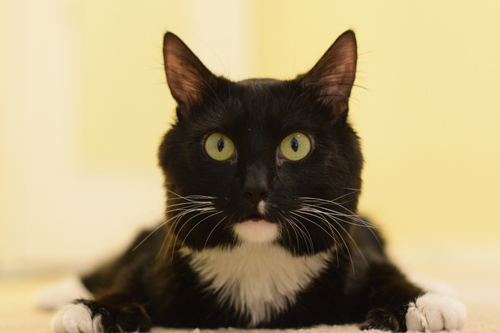
No, CH isn’t fatal, and cats with cerebellar hypoplasia have normal lifespans. Plus, because it’s non-progressive neurological condition, the symptoms won’t get worse over time. Euthanasia should only be considered for cats with cerebellar hypoplasia if their quality of life is severely compromised and they are experiencing significant pain or suffering. In most cases, however, cats with this condition can enjoy a good quality of life with proper care and management.
Should I adopt a cat with cerebellar hypoplasia?
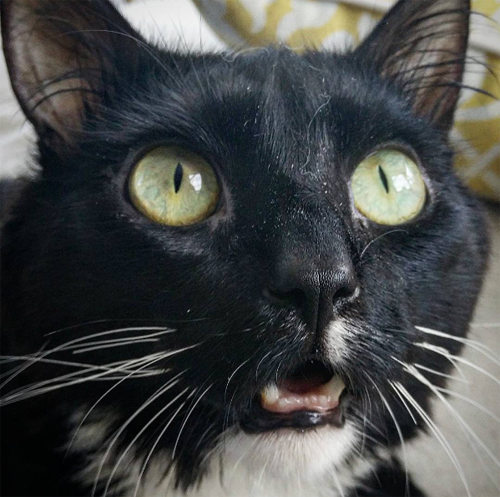
Yes, if you’re able to accommodate their special needs, then you should definitely adopt a cat with CH! They are incredibly inspiring, and people with wobbly cats often say they are more loving and affectionate than typical felines.
Feline Cerebellar Hypoplasia Infographic
To help explain cerebellar hypoplasia in cats, we created an infographic you can share online and also download and print.
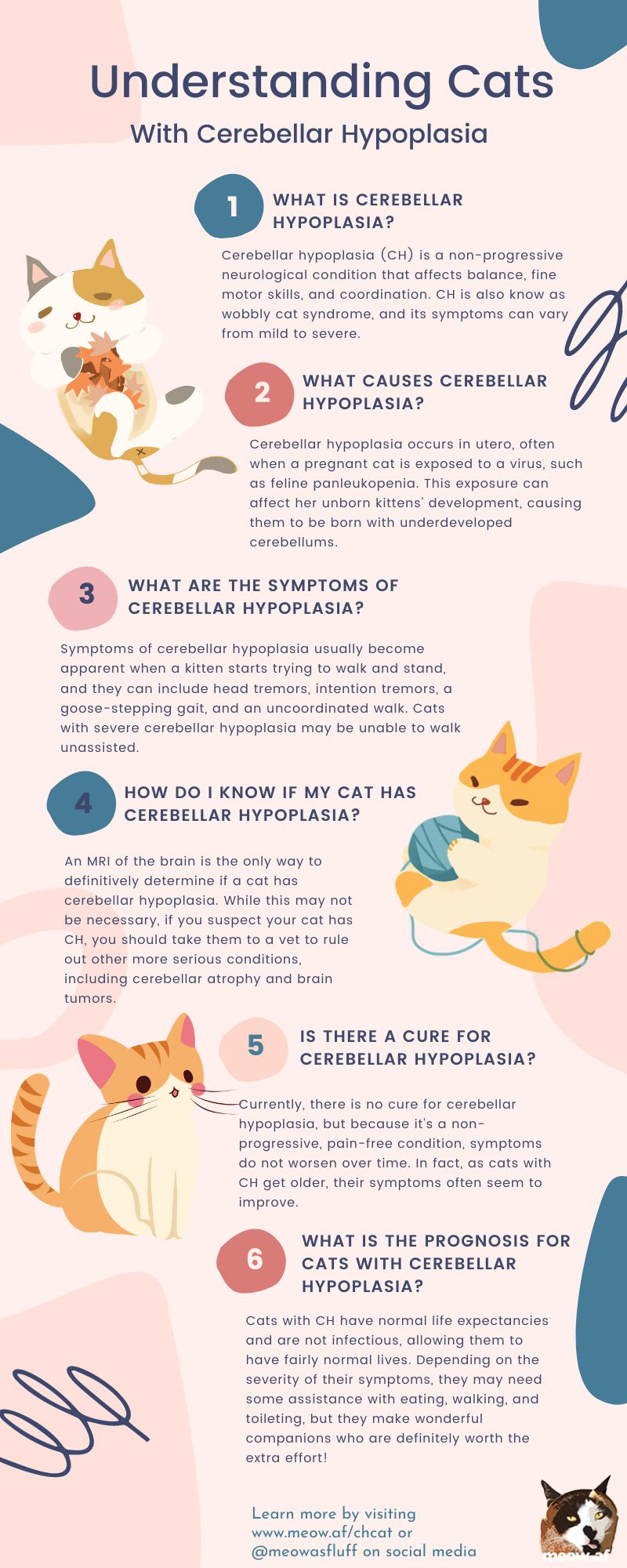
Essentials for CH Cats
We’ve also created our list of essentials for CH cats, because we have extensive personal experience caring for wobbly kitties.
Videos and Articles About CH Cats
If you want to learn more about individual CH cats, you can read the articles we’ve written about them and even watch the videos we’ve created.
Read our article about Natalie


